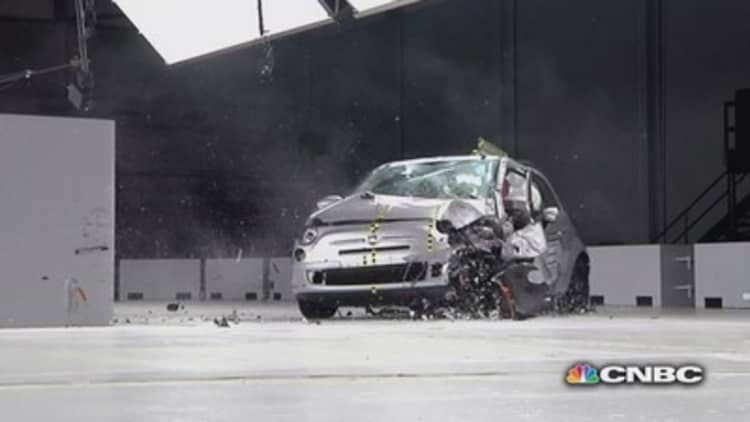Federal regulators plan to propose a long awaited test for side crash protection in child safety seats Wednesday and the proposal calls for a new 3-year-old crash test dummy.
The proposed National Highway Traffic Safety Administration test simulates a side impact vehicle crash and requires car seats to safely restrain a child by preventing harmful head contact with an intruding vehicle door and reducing the crash forces transmitted to the child's head and chest, NHTSA says. It would cover seats for children up to 40 pounds.
(Read more: Youth sports is a $7 billion industry—and growing)
NHTSA estimates that the proposal would save five lives and prevent 64 injuries annually.
The proposal has been under consideration for a decade and child seat makers have been introducing models marketed to protect children in side crashes. Safety 1st, for example, sells two models—the Advance 70 Air Convertible Car Seat and the Elite 80 3 in 1 Car Seat—which both provide full body side impact protection.
"In 2003, when this rule-making began, we knew that kids were being hurt in side-impacts, but we didn't know what the mechanisms of injury were," child safety advocate Joseph Colella said Wednesday. "Developing appropriate test devices and configurations could not begin until that was better assessed."
More from USA TODAY:
Are you sitting down? Your heart failure risk is higher
Fewer women seek help for infertility, data show
Airports add outlets to serve power-parched passengers
A federal rule would help assure consumers that all seats sold meet a minimum level of safety in side crashes.
"Today's proposal will give parents and car seat makers important new data on how car seats perform in side crashes," said Transportation Secretary Anthony Foxx.
Under the proposal, car seats would be tested in a specially-designed sled test that simulates a "T-bone" crash, where the front of a vehicle traveling 30 mph strikes the side of a small passenger vehicle traveling at 15 mph.
(Read more: What's it cost to have a baby? Try $3000—or $37000)
This test is the first of its kind in the world being proposed for regulation. It simulates both the acceleration of the struck vehicle and the vehicle door crushing toward the car seat. Along with using an existing 12-month-old child dummy, the proposed test will also utilize a planned side impact dummy representing a 3-year-old child. The agency proposed a 3-year timeframe for car seat manufacturers to make any necessary changes to meet the proposed requirements upon final rule publication.
This year will be a big one when it comes to federal rulemaking on child seats.
NHTSA is also expected to issue a final rule very soon on the child-seat attachment system known as LATCH for Lower Anchors and Tethers for Children. Comments on the rule close Wednesday. The rule is expected to go into effect by late next month.
Parents are expected to be advised to use seatbelts—instead of LATCH—to secure car seats if the child and seat weigh more than a certain amount, likely 65 pounds combined. The agency may require car seat manufacturers to place a label, which would go on the car seat, specifying the maximum weight a child can be secured using LATCH.
For example a car seat weighing 25 pounds would need a label that says, "LATCH may only be used for children weighing 40 pounds or less." This is to ensure LATCH can withstand the forces from all types of collisions, NHTSA says.

Child seat makers filed a petition to block the rule because they think it would make an already confusing process even worse.
NHTSA should focus on making the process as easy for parents as possible, said Julie Vallese, spokeswoman for child seat maker Dorel.
"Little kids latch, big kids belt," she said.
Colella, who also wants the rule changed, said the expected rule could prove to be dangerous.
Most parents don't know how to properly secure a car seat with a seatbelt, Colella said, and LATCH, which has been mandated since 2002, was designed to help alleviate that confusion. Limiting LATCH will increase the likelihood that people will get it wrong, he adds.
"There is no evidence of the anchors failing," Colella said.
"The reason LATCH was introduced was because parents weren't getting it right," Colella said. "More parents get it right with LATCH."
After the side impact proposal is announced Wednesday at the Washington, D.C. auto show, the public will have about three months to comment. The regulations will be finalized after the agency reviews the comments and addresses any issues raised.
That can take months or years, but the agency is expected to move quickly now that the proposal has taken so many years. Seat makers would also have three years to meet the rule, but most are hoping their seats with side impact protection already come close. At that point, "we will have the most realistic testing and the safest car seats in the world," said Colella.
—By Jayne O'Donnell and Fola Akinnibi, USA Today.
Contributing: Associated Press

